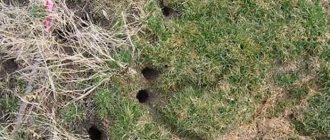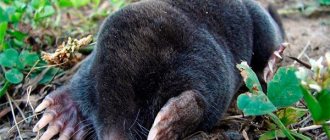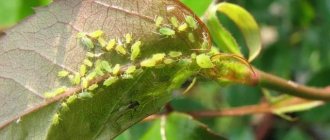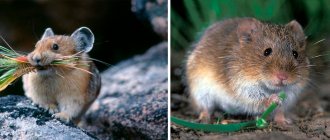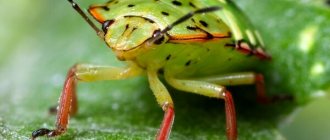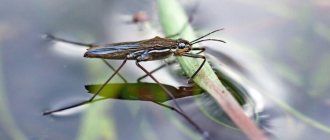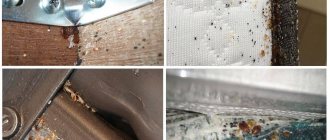Fighting the raspberry bug. How dangerous is the pest? Features of insect pests. Habitat and breeding of stink bugs. Which methods are the most effective? How to carry out processing correctly. Traditional methods, chemicals, biological preparations. Tips and tricks.
Every gardener grows aromatic, healthy, tasty raspberries on his plot. It takes a lot of time and effort to grow it; you need to look after the bush and take care so that it rewards you with a good harvest. But, unfortunately, all efforts may be in vain if this plant is attacked by a terrible pest - the bug. It can harm the entire crop, and berries that have been attacked by the parasite become disgusting in taste. If a bug is spotted on a raspberry, it must be dealt with immediately, otherwise the owners will lose their entire harvest. Since raspberry bushes are infested with bugs quite often, there are more than enough means to fight them. The main thing is to choose the most effective result so as not to waste precious time.
Description of the pest
The raspberry bug got its name not because it in any way resembles raspberry fruits, not because of the color or because of the smell, but only because it lives on raspberry bushes. If we say a few words about science, then in total about 4000 species of these pests are known. Regarding the crimson bug, it lives throughout our country and belongs to the stink bug species.
The pest has an oval-shaped body; an adult grows no more than 15 mm in length. The entire body is covered with small villi; the antennae and wings of the insect are yellowish-brown in color. As a protective camouflage, it changes its body color; in early spring it has a bright green color, and in the fall it turns brown.
They tolerate winter well, going into hibernation. They choose secluded places for wintering, the most common being fallen leaves or garbage. But they can also settle down perfectly for the winter in the bark of a tree or choose a secluded corner in the house. They wake up in early spring and remain active until late autumn.
Even though they are crimson bugs, they can have a very varied diet. They can settle on currants or gooseberries, and will not pass by other berry bushes. In addition, they will not ignore delicious cherries.
To prevent population growth and ensure prevention on your site, you should weed weeds as often as possible. The habitats of the larvae are areas drowned out by vegetation; they love humidity and avoid those areas with good ventilation.
Berry shield.
The berry bug is a member of the stink bug family, which numbers more than 4,000 species. This insect is 8-12 mm in length, with a body that resembles a slightly oblong triangle and has a very unpleasant smell, familiar to many gardeners. This is the smell of the liquid that an insect secretes in case of danger. For this feature, the berry bug also received the name stink bug. The cimicic acid secreted by the shield bug, which has such a repulsive odor, is absolutely harmless to humans, but can be destructive to other insects.
The bug has a gray-yellow or red-brown color. Adult insects have the ability to change color, thus camouflaging themselves with their environment. The insect's body is covered with many densely growing hairs that form a whole cover.
The berry bug is distinguished from other representatives of the family by the color of the sides of the body and mustache. They have a striped, yellow-brown color. The insect's abdomen is colored with the same stripe.
The habitat of the berry shield bug is our vegetable gardens and orchards. The bug feeds on juice extracted from the leaves and fruits of berries, fruits and even vegetables. The shield bug sucks out all the juices from the green pulp of leaves or fruits, digging its proboscis into them. Brown spots often remain at the site of such punctures. Leaves and berries affected by bugs dry out. And entire invasions of insects on a plant are fraught with its death.
Berry bugs overwinter in fallen leaves. In the spring, with the onset of warm days, they crawl out of their hiding places in search of food. During this period, when the sap flow of the berry bushes has not begun and the leaves have not appeared on them, the insect does not refuse weeds.
As soon as leaves appear on raspberry or currant bushes, stink bugs actively colonize them in order to lay eggs. These formations may not be immediately noticed, since females lay eggs on the back of the leaves. This process lasts approximately 10 days, and after one and a half to two months the larvae will begin to hatch. At the very beginning, the larvae group together, so if you inspect the bush from time to time, it is much easier to detect and destroy such “settlements.” And when the insects have managed to crawl throughout the plant, it will be more difficult to fight them. The larvae, in appearance, are quite similar to adult insects, have the same gray color and a body covered with fluff, which, over time, turns into dense hair.
Shield insects pose a serious threat to the plant and harvest only when there is a large concentration of them on a berry bush. In this case, it will not be possible to do without the use of chemicals. In the fight against small numbers of insects, quite gentle methods and methods are also suitable.
First of all, pests can be collected manually and, if possible, the bushes can be inspected regularly, promptly removing the detected stink bug.
Some gardeners practice spraying berry bushes with a solution of infused onion peels. To prepare the infusion, about 200 grams of the dry product is poured into a bucket of boiling water and left to infuse for five days. Next, the resulting infusion is filtered and the bushes are sprayed with it. Such treatments are carried out at least three times, every 5 days. In addition to onion peels, you can use wood ash, strong tobacco and mustard to prepare the infusion.
In order to prevent the appearance of berry stink bug, you can plant black cohosh, which is popularly called black cohosh, in your area, since the aroma emitted by the plant repels these insects.
Regular weeding of weeds, as well as cleaning up fallen leaves in which scale insects like to settle, will also help prevent the appearance of pests.
If, despite the measures taken, the number of insects increases, the use of chemical insecticides cannot be avoided. Karbofos or Phosfamide to control pests .
How do they get into gardens?
As mentioned earlier, they overwinter in fallen leaves, this can be forests, bushes, and other areas. For example, they can fly to summer cottages from the nearest forest belt. Just fly in, because they fly well, albeit over short distances. Regarding how they choose a place for future habitat, they are guided by smell, since these insects have a developed sense of smell.
After they have chosen a new habitat, they begin to reproduce. They leave clutches of eggs on young leaves on the underside. One clutch can contain up to 40 eggs. The development period from egg to larva is about a week. Both adults and larvae feed on plant sap; for this they select leaves and shoots. If their colony has reached a large number, then they will certainly cause great harm to the plants.
When the berries begin to ripen in the garden, then the presence of stink bugs is more than noticeable. During this period, they become very noticeable, because, having tasted the sweet juice of the berries, they leave behind “fragrant” traces. In addition, their presence is confirmed by damaged berries. The berries that have been infected by the parasite have dark spots and dried areas. The leaves of the bush are also damaged; dark spots are clearly visible on them.
If we talk about orderlies, birds that eat most insects, thereby saving various pests from catastrophic infestations, then they disdain raspberry bugs, which allows parasites to quickly multiply without any barriers. Therefore, if you do not fight them, they can not only spoil the harvest a little, but cause significant harm.
Read more about scale insects on currants.
The appearance of this pest on currants is fraught with slower growth and development of the bush, drying out of the foliage, loss of yield and death of the entire plant.
The size of the scale insect is very small, so it is sometimes difficult to detect the pest in time. The length of the scale insect does not exceed 4 mm, and it usually settles on the underside of the leaf or at the junction of the leaf and the stem. If you find small spots on currants, take a closer look at them, because this is how the scale insect “camouflages itself.”
The probability of damage to currant plantings by scale insects is quite high. The insect is easily carried by the wind and carried by animals. Infection can occur from poor-quality planting material or soil substrate.
This pest feeds on the sap of plants, interfering with their life processes; the insect draws out nutrients, depriving the bush of the forces necessary for growth and development. This parasite is quite dangerous; in a couple of years the scale insect can destroy large-scale currant plantings.
An important preventive measure to prevent the pest from multiplying is hilling the plant. Shrubs should be earthed up in the fall, making small earthen mounds. In the spring, after the snow melts, the soil must be removed.
If a scale insect is detected, the bushes must be immediately isolated. For these purposes, you can use polyethylene film. Shrubs growing in the neighborhood should be very carefully inspected and the same measures should be taken if insects are detected.
When treating bushes with various solutions, it should be remembered that it will be difficult to remove adult insects in this way, since their body is reliably protected by a rather dense shell. Therefore, you will most likely have to remove them from the bush manually. Using a sponge and a thick soap solution, you need to treat every leaf and shoot of the infected plant. This is a very labor-intensive task, but necessary. In this case, there is no need to rush, otherwise those insects that you did not remove will soon multiply and colonize neighboring shrubs, increasing the affected area.
If this does happen, in order to save the bushes, you will have to use chemical insecticides. The most effective against scale insects are neonicotinoids - a small class of organic compounds that, upon contact with insects, cause paralysis and death. These insecticides include Mospilan, Colorado, Aktara, Tanrek .
Treatment is carried out by spraying with a working solution prepared in accordance with the instructions for use of these drugs. To destroy the pest, more than one treatment will be required, since, in addition to adult individuals, the bush usually contains insect larvae or eggs. Only after repeated treatments can one count on preserving the shrub.
In addition to the above insecticides, hormonal and organophosphorus preparations can be used in the fight against scale insects, including: Pyriproxyfen, Iskra, Kemifos , etc.
The number of treatments should also be at least three, with a frequency of no more than one week.
When using chemical insecticides, it is important to remember safety precautions. People suffering from allergic diseases or bronchial asthma should not use such drugs at all. You also need to remember that the substances included in insecticides can be harmful to bees.
In this case, you can use folk remedies to combat the pest. Next, we will consider the most effective of them.
What to expect from a pest?
Despite the fact that the fight against them is carried out because they spoil the harvest, they do not eat the berries of raspberries and other shrubs. The thing is that they feed exclusively on the juice of the bush itself.
But this leads to the following consequences:
- The plant loses its juice and weakens;
- Leaves a stinky mark on the berries, thereby making them unsuitable for consumption;
- In places where they suck out the juice, fungal spores can enter and the plant becomes sick.
It is worth saying that a small amount of these parasites cannot cause much harm. Their life cycle is quite difficult, although females lay eggs twice a season, not all of them survive. But sometimes this is enough to give a chance to the development of large colonies. Adults and larvae have no other food sources other than bushes, and to develop they must eat well and eat a lot. Therefore, bushes that are attacked by stink bugs will have weak shoots, weakened tops, and dried out damaged parts.
How do they harm plants?
Despite numerous misconceptions among gardeners, bedbugs are interested in the sweet juice from the fruit, and not the berries themselves. But even so, they can cause significant harm to the bushes:
- By weakening plants and leaving them vulnerable to fungal spores;
- Leaving persistent secretions on the fruits and giving them an unpleasant taste.
No less harm is caused by the larvae, which feed on the sap of the leaves during the growth process. The bushes affected by them are doomed to dry out and die.
Read: How to properly harvest and store beets
Bedbugs reproduce very actively, leaving eggs on the bottom of the leaf, so the entire raspberry tree can be subject to harmful influence.
How to fight?
In order to get rid of pests, bushes are treated, using both specialized means and traditional methods. You should also not forget about preventive actions that will prevent the appearance of large colonies.
Specialized means
It should be said that there is no separate means that would be aimed at destroying the raspberry bug. All chemicals have a wide spectrum of action and help fight pests in gardens and vegetable gardens. When used correctly, these products do not harm shrubs.
These include:
- Fufanon;
- Aktellik;
- Phosfamide;
- Karbofos.
For effective results, treat plants 2 times. It is very important to follow these rules:
- The first treatment should be carried out in the spring before the buds open.
- The second is carried out just before flowering.
- It is forbidden to carry out the procedure during the flowering period, this will harm the berries themselves, they will become unsuitable for consumption, as they will absorb toxic substances. In addition, during this period, chemicals will harm the bees.
- It is also prohibited to spray the ovaries, due to pesticides that will end up in the fruits.
Regarding the disadvantages of such treatments. The fact is that pests can get used to chemicals, they develop immunity, and then they will need to change the product to achieve results. Another disadvantage is financial costs.
Traditional methods
For many years, gardeners have been using folk remedies on their plots that have proven their effectiveness in practice.
They have many advantages, the main ones:
- Harmlessness. The use of such products is absolutely safe for people and animals, and, of course, harmless to plants.
- Availability and low cost. Most recipes include ingredients that are found in every home, and if you need to purchase them, they are very cheap.
- Efficiency. The positive result has been proven in practice.
There is also a drawback. Such treatments will need to be carried out repeatedly. Due to the fact that these products have a repellent effect, bedbugs leave their habitat, but can return as soon as they feel safe.
The most popular means include:
- Mustard. You will need to dilute mustard powder in water, proportion 1:10. Stir well and apply immediately after preparation. The bushes are sprayed in any convenient way; you can use a regular broom or brush.
- Onion peel. From it you need to prepare the following solution. Take any container and pour the husk into it. Next, fill it with water and let it brew for 5 days. After which you can start spraying; for this we dilute the solution with water in a ratio of 1:4. This solution can be stored for about 2 months, the main thing is to choose a cool place out of direct sunlight. Bushes are processed 5 or more times during the season.
Another accessible, simple and convenient folk method is planting black cohosh. This wonderful, beautiful plant, which is also called black cohosh, is planted near a raspberry tree or between bushes. It is a natural repellent that is absolutely harmless to plants and people. The advantages of this method are obvious: you do not waste effort, time and money on processing, the garden is beautiful and there are no bugs.
Biological agents
Now you can purchase biological products, which, unlike chemical ones, are absolutely harmless, but cope with pests just as effectively.
- Boverin. The active substance of the drug is fungal spores. The mechanism of action is as follows: when contact is made, the fungi fall on the bug and penetrate the body. Next, the spores develop, which causes the production of a toxin that kills the insect. In addition to direct contact, infection occurs between individuals, so one bug that comes into contact with the drug brings spores on itself and infects other individuals. It is necessary to work with this substance while using protective equipment, as allergic reactions may occur.
- Bitoxibacillin. Here the basis of the drug is bacteria, which have a fatal effect on parasites. This drug is quite popular and has been used with great success for more than 30 years. Regarding the shortcomings, it is worth noting the unpleasant smell of the product. Another minus is the slightly slower result; the parasites die after treatment on about 3 days.
